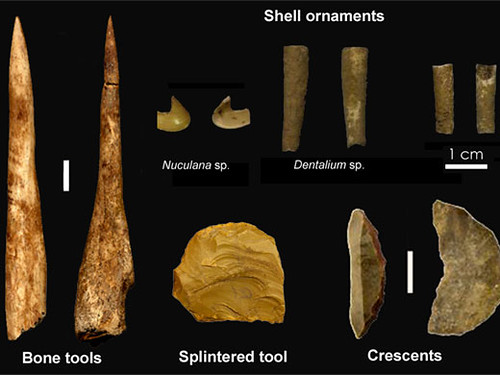 |
| Uluzzian artifacts from Grotta del Cavallo, Apulia, southern Italy. Credit: Annamaria Ronchitelli and Katerina Douka |
... Now,
an international scientific team led by Katerina Douka of the
University of Oxford is reporting the results of a
new study, concluding
that the Uluzzian arose or arrived in what is present-day Italy and
Greece shortly before 45,000 years ago, with its latest phases placed at
around 39,500 years ago, and "its end synchronous (if not slightly
earlier) with the Campanian Ignimbrite eruption".* The Campanian
Ignimbrite eruption refers to the eruption of the Archiflegreo volcano around 37,000 years B.P.,
coincidental or correlated to Middle Paleolithic (beginning 300,000
years ago) to Upper Paleolithic (beginning between 50,000 and 40,000
years ago) cultural transitions and the theorized replacement of Neanderthal populations
by anatomically modern humans in southeastern Europe. The replacement
theory and the Archiflegreo volcanic eruption as a causal element within
this model has been a subject of continuing debate.
To
determine the new dates, the researchers integrated the results of new
radiocarbon dating tests and a Bayesian statistical approach on samples
from four caves where Uluzzian artifacts have been found in Italy and
Greece (Cavallo, Fumane, Castelcivita and Klissoura 1). In addition to
constructing a new chronology for the Uluzzian, they also examined the
culture's appearance, its time and space spread and its correlation to
earlier and later Palaeolithic stone tool assemblages (i.e., Mousterian,
Protoaurignacian) within the relevant geographic regions. [...]
popular-archaeology.com








No hay comentarios:
Publicar un comentario